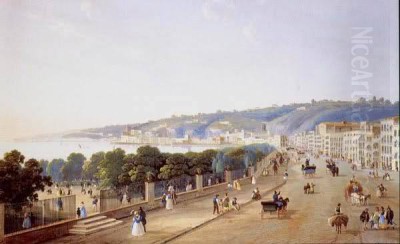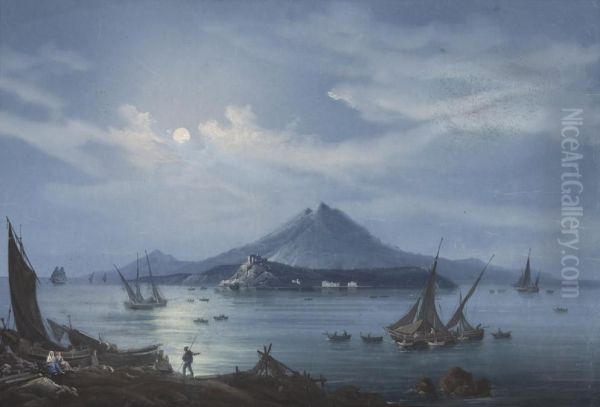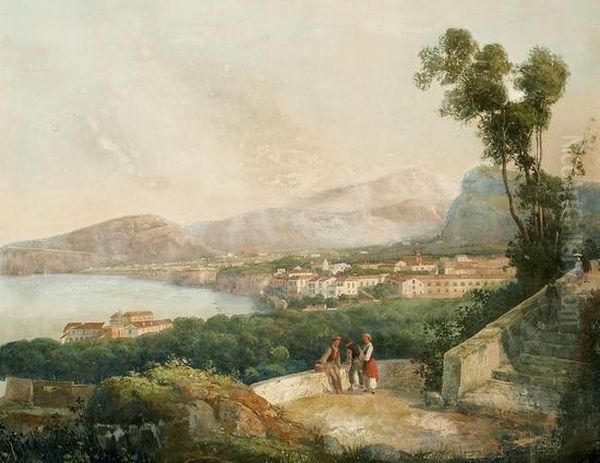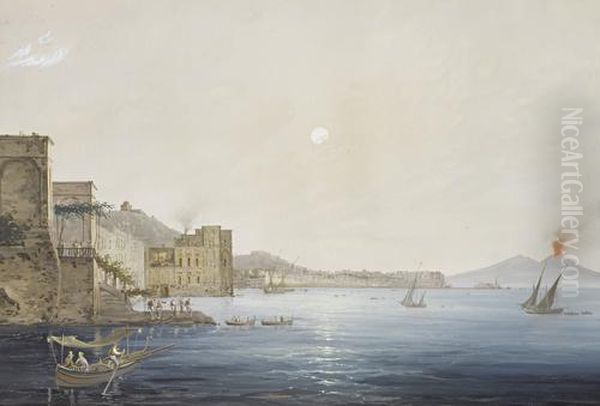Introduction: Clarifying Identities

The history of Italian art and culture occasionally presents figures whose names echo through different fields, sometimes leading to confusion. Such is the case with Gioacchino La Pira. It is essential, from the outset, to distinguish Gioacchino La Pira, the artist (1839-1870), who is the subject of this exploration, from the significantly more prominent 20th-century figure, Giorgio La Pira (1904-1977). Giorgio La Pira was a distinguished Italian politician, scholar, law professor at the University of Florence, Mayor of Florence, and a key participant in drafting Italy's post-World War II constitution. He was known for his deep Catholic faith, commitment to peace and human rights, and sometimes controversial political actions.
This article, however, focuses solely on Gioacchino La Pira, the 19th-century painter. Born in Naples in 1839 and active primarily in the late 1860s until his death in 1870, Gioacchino La Pira dedicated his artistic talents to capturing the unique light, drama, and beauty of his native city and its surrounding landscapes. Working predominantly in watercolor and gouache, he contributed to the rich tradition of Neapolitan view painting, leaving behind a body of work admired for its detail, vibrancy, and atmospheric quality. His life and career offer a glimpse into the artistic milieu of Naples during a period of significant historical transition.
A Neapolitan Artist's Life and Times
Gioacchino La Pira entered the world in Naples in 1839, a city that was then the bustling capital of the Kingdom of the Two Sicilies. Naples, for centuries, had been a magnet for artists, drawn by its stunning natural setting dominated by the Bay of Naples and Mount Vesuvius, its rich history stretching back to antiquity, and its vibrant street life. The city was a crucial stop on the Grand Tour, ensuring a steady stream of international visitors and patrons, which in turn fostered a thriving market for landscape and view painting, known as vedute.

La Pira's formative years would have coincided with the latter part of the Bourbon monarchy and the tumultuous period leading up to and including the unification of Italy (the Risorgimento), which saw Naples incorporated into the new Kingdom of Italy in 1861. While the provided sources focus on his artistic output from the late 1860s, it is reasonable to assume his training and early development occurred within this dynamic Neapolitan artistic environment.
His period of documented activity is relatively brief, concentrated in the years just before his death in 1870. This suggests either a late start to his professional career, a short-lived period of peak production, or simply that records of his earlier work have not survived or are yet to be widely recognized. Regardless, the works attributed to him from this time demonstrate a mature and skilled hand, adept at capturing the specific atmosphere of the Neapolitan landscape. His life was cut short in 1870, ending a promising, if seemingly brief, artistic career.
The Artistic Landscape of 19th Century Naples
To understand Gioacchino La Pira's work, it is helpful to place him within the context of Neapolitan painting in the mid-19th century. The city was home to a flourishing school of landscape painting, often referred to as the School of Posillipo. This movement, emerging in the early 19th century, marked a shift away from the purely topographical or classically idealized landscapes of earlier periods towards a more direct, atmospheric, and often romanticized depiction of nature.
Key figures associated with the School of Posillipo include the Dutch painter Anton Sminck Pitloo, who settled in Naples and became a highly influential teacher, and his Italian followers like Giacinto Gigante. These artists emphasized painting en plein air (outdoors) to capture the immediate effects of light and atmosphere, a practice that resonated deeply with the unique luminosity of the Neapolitan coast. Their work often featured intimate views, coastal scenes, and studies of light, rendered with a fresh and spontaneous touch, frequently in watercolor or oil sketches.
Other notable Neapolitan landscape painters active during or overlapping with La Pira's time include Salvatore Fergola, known for his dramatic historical and landscape scenes, and Teodoro Duclère, another artist associated with the Posillipo tradition. Figures like Achille Vianelli, Consalvo Carelli, and Gabriele Smargiassi also contributed significantly to the Neapolitan landscape genre during this era. The focus was often on the picturesque, the dramatic interplay of sea, sky, and land, and the ever-present, sometimes menacing, Vesuvius.

Furthermore, Naples continued to attract foreign artists. While the peak of the Grand Tour might have passed its zenith by La Pira's active period, the city's allure remained. Earlier visits by masters like J.M.W. Turner, who captured the volcanic drama and intense light, left an indelible mark. Contemporaries from other parts of Italy and Europe, such as Camille Corot (though his visits were earlier) or the Russian painter Sylvester Shchedrin, also spent time painting the Neapolitan scenery, contributing to an international dialogue about landscape representation. Even artists associated with different Italian movements, like the Macchiaioli's Giovanni Fattori, though focused on different themes and styles, were part of the broader artistic ferment of unified Italy. Similarly, the Venetian veduta tradition, carried into the 19th century by artists like Ippolito Caffi, provides a parallel context for view painting in Italy.
La Pira's Artistic Focus: The Bay and the Volcano
Gioacchino La Pira's known oeuvre centers firmly on the iconic landscapes of Naples and its environs. He repeatedly turned his attention to the Bay of Naples, a subject beloved by artists for centuries for its sweeping curve, the quality of its light, and the dramatic backdrop of Mount Vesuvius. His depictions often capture the interplay of light on water, the silhouettes of boats, and the distant outlines of the surrounding coast and islands.
Mount Vesuvius, the active volcano looming over the bay, was another major subject. La Pira depicted it in various states, including dramatic nighttime eruptions. These works tap into the Romantic fascination with the sublime – the awe-inspiring and sometimes terrifying power of nature. The contrast between the fiery eruption and the dark sky or the moonlit bay offered rich opportunities for exploring dramatic light effects, a challenge La Pira seems to have embraced.
His interest extended beyond the immediate bay to the nearby islands and coastal towns. Works depicting Ischia, Procida, Sorrento, and the small island of Nisida demonstrate his commitment to capturing the specific character of these locations. Fishermen often feature in his scenes, particularly at evocative times like sunset, adding a human element and narrative touch to the landscapes. These scenes align with the picturesque tradition popular in the 19th century, celebrating the beauty of coastal life and scenery.
Mastery of Watercolor and Gouache
The available information indicates that La Pira primarily worked in watercolor and gouache (an opaque watercolor). These media were particularly well-suited to capturing the luminous atmosphere and vibrant colors of the Mediterranean coast. Watercolor allows for transparency and delicate washes, ideal for rendering skies and water, while gouache provides opacity and strong color, useful for defining forms and adding highlights or depicting scenes with strong contrasts, such as nighttime eruptions.

Descriptions suggest his style was characterized by detailed observation and a vivid rendering of natural phenomena. He paid close attention to the specifics of place and the effects of light and shadow, aiming for a convincing representation of the scenes before him. While rooted in the observational tradition of veduta painting, his work likely incorporated the more atmospheric and romantic sensibilities prevalent in the mid-19th century, influenced perhaps by the School of Posillipo's emphasis on capturing mood and feeling alongside topographical accuracy.
Several of his documented works share similar dimensions (around 30 x 25 cm or 11.5 x 10 inches), which might suggest they were created as part of a series or album, a common practice for collections of views intended for travelers or collectors. The relatively large size for watercolors of this type indicates ambition and a desire to create substantial, finished works rather than mere sketches.
Representative Works
While a complete catalogue raisonné may not be readily available, several specific works attributed to Gioacchino La Pira provide insight into his subjects and style:
Nisida: This work depicts the small volcanic islet of Nisida, located near Posillipo in the Bay of Naples. The description mentions a backdrop of Vesuvius erupting, creating a dramatic juxtaposition of the tranquil island and the powerful volcano.
The Bay of Naples at night: Capturing the iconic bay under nocturnal conditions allowed La Pira to explore the effects of moonlight or artificial light on the water and cityscape, a theme popular among artists seeking atmospheric and romantic effects.
Vesuvius erupting at night: A recurring theme, showcasing the sublime power of the volcano. Such scenes were highly sought after by visitors and collectors, offering a dramatic memento of Naples' most famous natural wonder. The nighttime setting would emphasize the fiery spectacle of the eruption.
Fishermen at sunset, Ischia beyond: This title suggests a picturesque scene combining human activity with a specific location (the waters off the island of Ischia) and time of day (sunset). Sunset scenes allowed artists to explore warm color palettes and the transient effects of light.
Procida, Carmina, and Sorrento: These titles indicate further explorations of the islands and coastal towns around the Bay of Naples, demonstrating La Pira's dedication to documenting the region's diverse landscapes. Carmina might refer to a specific location or perhaps a more allegorical or genre scene, though context suggests a place name is more likely within his landscape focus.
These works collectively paint a picture of an artist deeply engaged with his local environment, skilled in watercolor and gouache, and focused on capturing the celebrated views of the Neapolitan region with detail and atmospheric sensitivity.
Patronage and Legacy

A significant point mentioned in the source material is the connection between Gioacchino La Pira and Maria Sophie of Bavaria (1841-1925). She was the last Queen Consort of the Kingdom of the Two Sicilies, wife of Francis II. After the fall of the monarchy during Italian unification, she lived in exile but remained a notable figure. The fact that she owned a large album of La Pira's watercolors depicting Naples and its surroundings speaks volumes about the quality and appeal of his work.
Royal or high-status patronage was crucial for artists in the 19th century, providing financial support and enhancing reputation. Maria Sophie's collection suggests that La Pira's views were considered desirable acquisitions, likely appreciated for their artistic merit and as evocative souvenirs of the kingdom she had lost. This connection places La Pira's work within the circles of aristocratic collecting.
Today, Gioacchino La Pira is perhaps not as widely known as the leading figures of the School of Posillipo like Pitloo or Gigante. His relatively short documented period of activity and the potential confusion with his namesake, Giorgio La Pira, may have contributed to his comparative obscurity. However, his works continue to appear on the art market, valued for their skillful execution and their charming depictions of 19th-century Naples.
His legacy lies in his contribution to the Neapolitan veduta tradition during a period of transition. He captured the enduring beauty of the region's landscapes using the delicate and expressive medium of watercolor, creating works that appealed to both local and international tastes, including royalty. His paintings serve as valuable visual documents of famous sites like Vesuvius, the Bay of Naples, Ischia, and Sorrento as they appeared in the mid-19th century, rendered with an eye for detail and atmosphere.
Conclusion: A Painter of Naples
Gioacchino La Pira (1839-1870) remains a figure primarily defined by his artistic output during a brief but productive period in the late 1860s. As a Neapolitan painter specializing in watercolors and gouaches of his native city and its stunning surroundings, he worked within a rich local tradition of landscape painting heavily influenced by the School of Posillipo and the demands of the Grand Tour market. His detailed and atmospheric views of the Bay of Naples, the dramatic eruptions of Vesuvius, and the picturesque coastal towns and islands found favor with collectors, including royalty like Maria Sophie of Bavaria.
While overshadowed by some contemporaries and easily confused with the 20th-century politician Giorgio La Pira, Gioacchino La Pira the artist deserves recognition for his skillful contribution to 19th-century Italian view painting. His works offer enduring images of a region that has captivated artists for centuries, rendered with the specific sensitivity and luminosity afforded by watercolor, capturing the unique light and spirit of Naples before his untimely death in 1870. He remains a testament to the enduring artistic allure of the Neapolitan landscape.